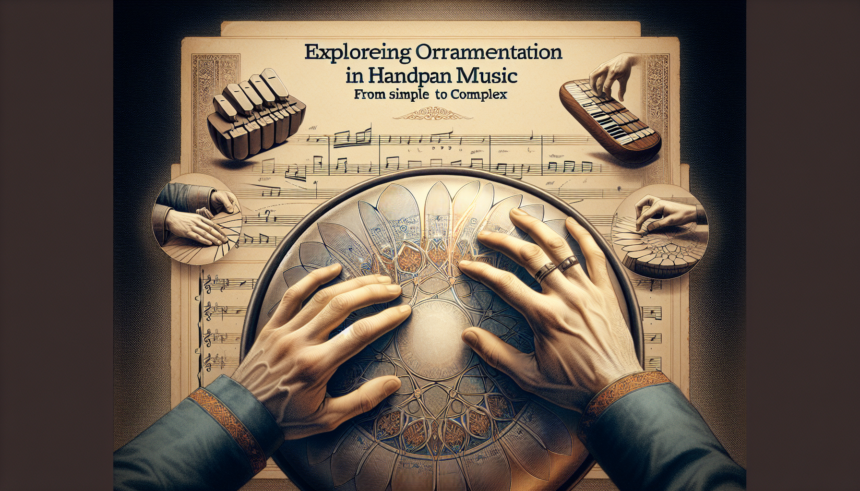Handpan music, with its ethereal sound and enchanting melodies, has gained widespread popularity among musicians and music enthusiasts alike. The art of playing this unique musical instrument involves various techniques, among which ornamentation plays a crucial role. Ornamentation enhances the expressiveness and emotional depth of handpan music, transforming simple melodies into complex, captivating pieces. This article delves into the different types of ornamentation in handpan music, ranging from simple embellishments to intricate patterns.
Understanding Ornamentation
Ornamentation in music refers to the embellishments added to a melody to enhance its beauty and expressiveness. It is an age-old practice found in many musical traditions around the world. In handpan music, ornamentation includes techniques such as rolls, flams, grace notes, trills, slides, and more. These techniques add texture and intricacy to the basic melody, allowing the musician to convey a broader range of emotions and moods.
Simple Ornamentation Techniques
Grace Notes
Grace notes are one of the simplest forms of ornamentation. They are quick, fleeting notes played just before the main note. In handpan music, grace notes create a subtle yet effective embellishment, leading smoothly into the main melody. For example, playing a quick note on a higher or lower tone field just before striking the target note can give the music a more fluid and dynamic feel.
Slides
Slides involve gradually transitioning from one note to another. This technique can be performed by sliding the fingers across the surface of the handpan. Slides add a lyrical quality to the music, making the transitions between notes smoother and more connected. This is particularly effective in slower, more meditative handpan pieces.
Rolls
Rolls are another fundamental ornamentation technique, where a series of rapid-fire notes are played in quick succession. In handpan music, rolls can be achieved by alternating strikes with both hands on the same tone field or close intervals. This creates a shimmering, continuous sound that enhances rhythmic complexity and adds a sense of movement to the music.
Intermediate Ornamentation Techniques
Trills
Trills involve rapidly alternating between two adjacent notes. This technique requires precision and control, as the musician must maintain a consistent tempo and rhythm. In handpan music, trills can be used to build intensity and excitement within a piece. By quickly alternating between two tone fields, the musician can create a vibrating, pulsating effect that captivates the listener’s attention.
Flams
Flams are a rudimental drumming technique that involves striking the surface with both hands almost simultaneously, but with one strike slightly preceding the other. This creates a thick, rich sound that adds depth to the music. In handpan playing, integrating flams can provide a percussive element, giving the melody a fuller, more robust texture.
Advanced Ornamentation Techniques
Ghost Notes
Ghost notes are subtle, barely audible notes that serve to enhance the rhythm without drawing too much attention to themselves. These notes are typically played softly and are used to fill in the gaps between the more prominent notes. Ghost notes require a high level of skill and control, as the musician must strike the balance between audibility and subtlety.
Polyrhythms
Polyrhythms involve playing two or more contrasting rhythms simultaneously. This technique is highly advanced and requires a strong sense of timing and coordination. In handpan music, polyrhythms can create complex, layered soundscapes that are both mesmerizing and intellectually stimulating. The musician must be proficient in maintaining independent rhythms with each hand, making this one of the most challenging forms of ornamentation.
Harmonics
Harmonics are produced by lightly touching the surface of the handpan at specific points while striking it. This results in a high-pitched, bell-like sound that overlaps the original note. Harmonics add an ethereal, otherworldly quality to the music, making it feel more expansive and immersive. Mastering harmonics requires a deep understanding of the handpan’s structure and resonance, as well as precise hand placement and timing.
Combining Techniques for Complex Ornamentation
As musicians grow more skilled, they often combine multiple ornamentation techniques to create highly intricate and expressive pieces. For instance, a player might use trills and harmonics together, or combine rolls and ghost notes, to craft unique sound textures. The creative possibilities are virtually endless, and the level of complexity achievable depends on the musician’s proficiency and imagination.
Combining techniques not only enhances the musicality of a piece but also allows the musician to develop a personal style. Each handpan player, through experimentation and practice, can discover their own unique approach to ornamentation, making their music distinctive and instantly recognizable.
Conclusion
Ornamentation in handpan music is an essential element that elevates simple melodies to new heights of expressiveness and complexity. From basic techniques like grace notes and slides to advanced methods such as polyrhythms and harmonics, ornamentation offers endless opportunities for creativity and emotional expression. By exploring and mastering these techniques, handpan musicians can develop their skills, broaden their musical horizons, and captivate their audiences with rich, textured, and compelling performances.
FAQs
1. What is the most basic form of ornamentation in handpan music?
The most basic forms of ornamentation in handpan music include grace notes and slides. These techniques are simple to execute and add subtle yet effective embellishments to the melody.
2. Are ornamentation techniques difficult to learn?
The difficulty of learning ornamentation techniques varies. While some techniques like grace notes and slides are easier to master, others like polyrhythms and harmonics require more practice and skill.
3. Can I combine different ornamentation techniques in one piece?
Absolutely! Combining different ornamentation techniques can create rich, complex, and unique musical textures. Experimenting with various combinations can help you develop your personal style.
4. How can I improve my ornamentation skills on the handpan?
Improving ornamentation skills requires regular practice and experimentation. Start with simple techniques and gradually progress to more complex ones. Learning from experienced players and taking lessons can also be beneficial.
5. What are ghost notes, and how are they used in handpan music?
Ghost notes are subtle, barely audible notes used to enhance the rhythm without dominating it. They require precise control and are often used to fill gaps between more prominent notes, adding depth and intricacy to the music.





